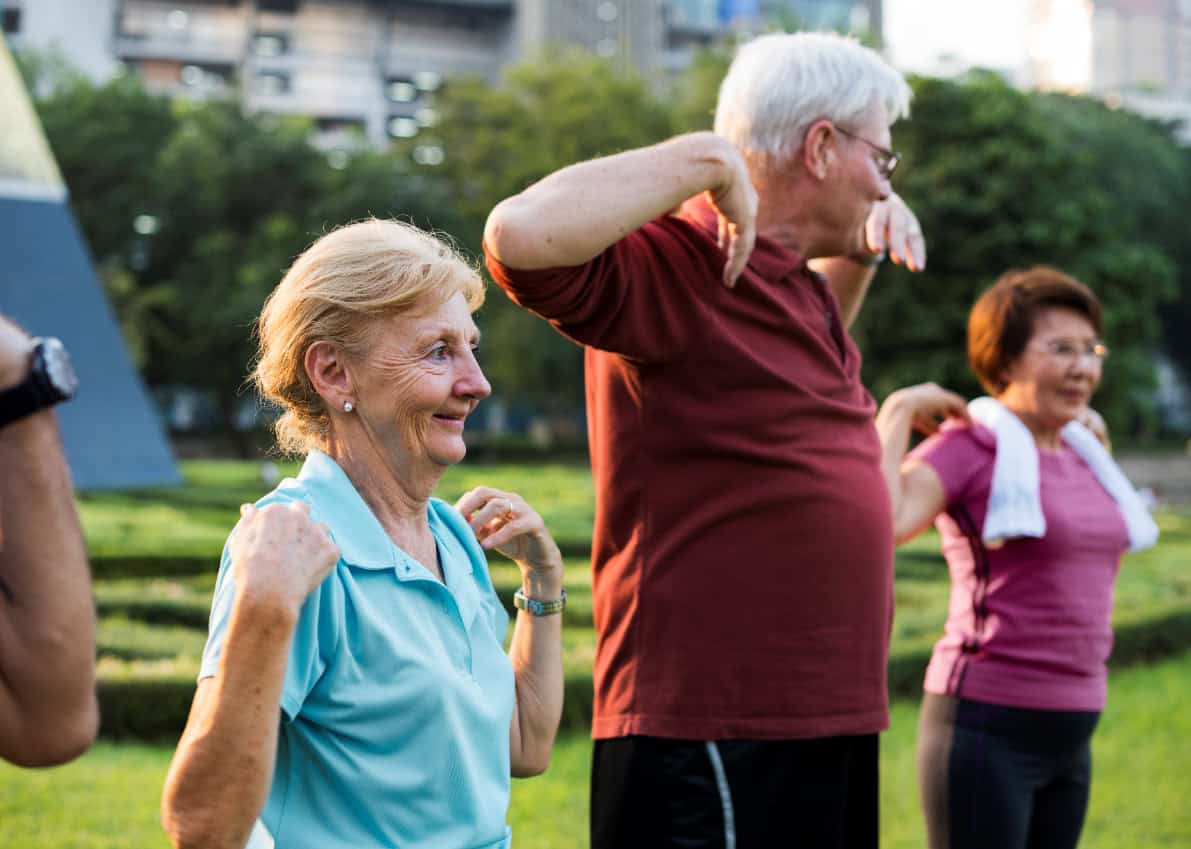One of the myths of senior living is that it’s lonely and isolated. For many seniors, living alone can be much more challenging and solitary.
Still, even at the most interactive, engaging senior living facilities, the importance of social interaction for seniors shouldn’t be overlooked. Loneliness and social isolation in the elderly can be detrimental to their mental and even physical health and wellbeing. Foster social connections for seniors by helping them discover ways to connect with family and friends. They may even make some new social connections along the way!
Social isolation is challenging for seniors, even in the best of times. Seniors who engage with their community, volunteer, attend religious services, and take classes often combat the effects of loneliness and isolation successfully. Those who are home-bound or more introverted can suffer.
Senior living facilities are often a wonderful social expansion for the elderly. They may make new friends, interact with peers, and enjoy activities that they wouldn’t have found had they been alone in their homes. Although many seniors choose to age-in-place, they may find themselves in a rehabilitation center or long-term-care facility in their later years. Many are pleasantly surprised to discover that they make new social connections and build a sense of community.
That said, loneliness and social isolation can be challenging for seniors across the board. It’s common to feel a bit blue and down during their first few days or weeks at a senior living facility. The transition to a new residence can be challenging, and building new social connections is daunting, especially for the shy or less outgoing.
Compounding the sense of isolation is a loss of familial connectedness, nostalgia for their previous home, and a sense of loss of independence. Some families are highly involved and ready to help their loved ones make the transition. Other seniors may have loved ones who live far away, or they may simply not have those strong social ties.
No matter the situation, there are ways to foster new social connections and encourage senior residents to engage with each other, the community, and their loved ones. Even if it’s from a distance or virtually, recognizing the importance of social interaction for seniors will help them thrive.
Here are 10 ways to encourage more social interaction for senior residents under your care.
1. Build a Community in Your Facility

There are times when seniors can’t interact with family and friends. During the Coronavirus pandemic, seniors had to stay quarantined to stay safe. But even during other times, loved ones get busy, can’t travel, or limit their visits. There are also plenty of seniors who don’t have many social connections left.
Senior living facilities must focus on creating a sense of community for their residents. Even on the tightest budgets, seniors shouldn’t be relegated to their rooms all the time or left alone for hours on end. One of the benefits of senior living is that it gives people a chance to interact with peers. They meet new friends and feel those common bonds.
To foster a sense of community, it’s important to do activities in common areas. Special mealtimes, movie nights, or games can help bring everyone together. Welcome new residents into the community and encourage them to get to know each other.
2. Encourage New Connections with Shared Interests
Anyone who’s worked in long-term care knows it can become like high school all over again in many ways. People naturally gravitate towards cliques and become friends. These social ties are great for helping seniors increase social interaction.
However, like high school, these groups can leave some folks feeling “left out” of the cool crowd. You can’t force friendships, of course, but by helping foster different interests, residents may discover new and exciting connections.
For example, showing a science fiction movie may draw out a different crowd than your typical romance or comedy. Some seniors may enjoy different art, exercise, and fitness activities, or even learning new skills. Providing diverse types of programming and an array of activities can help people discover new shared interests.
3. Promote Interactive Activities
We’ve all seen residents that end up spending most of the day in their room or suite, watching the news or old sitcoms. While socializing isn’t for everyone, all humans benefit from some level of engagement and connectedness.
Many residents enjoy television because it tells a story, and it often feels easier on the eyes than reading. But some residents may also enjoy theater, sharing stories, or listening to books read aloud (even audiobooks). These activities are more interactive and still appeal to their interests.
For social butterflies, game nights, dance classes, and socials are a great opportunity. Some folks are natural entertainers who love singing, chatting, and even dancing. Encourage these group activities for everyone, whether they prefer to jump in the action or cheer from the sidelines.
4. Teach the Importance of Social Interaction for Seniors

Sometimes seniors may not realize the importance of social interaction for their wellbeing. For many, assisted living or long-term care is their first experience living around other people (or their first experience in decades). They may believe that they don’t really “need” to make friends.
Share the physical, mental, and emotional benefits of socializing with your residents. Help them understand that social interaction can help strengthen their memory, improve cognition, help them feel happier, and ward off illness.
Getting more social has proven physical benefits. People who interact with others are more likely to keep their commitments to exercise and physical activity, and they’re even more likely to prioritize their health. All this can lead to longer, more fulfilling, healthier lives, which is a lot of benefit for a few minutes of daily conversation. As they say, “the more you know,” the more likely you are to follow through. Share this critical information with your residents to help them prioritize.
5. Connect with the Community
Encourage social interaction by finding opportunities to connect with the outside community. During the pandemic, facilities had to limit social interaction, and many visitation programs fell by the wayside. These programs can still go on or be restarted in different formats until it’s completely safe to have face-to-face interaction.
Many people in the community would love a way to help isolated seniors feel more connected. It may be drawing chalk art on the sidewalks leading up to your building, creating signs to greet seniors from their windows, or donating supplies for game nights.
Put out a community call for puzzles, gently used game items, books, and other materials. Ask for volunteers who would like to visit from afar until you can restart regular visitation. Many of these programs were vitally important to seniors and needed to continue in some form.
6. Offer Virtual Connections
If you had a school visitation program, you could still have students FaceTime or Zoom with residents to brighten their day. Reach out to the community through your NextDoor group or the local volunteer services chapter, and ask for folks who would be willing to help with virtual visits.
You may find people willing to offer online classes like cooking and craft demonstrations, history, finance, or technology lessons. Ask your local library or historian to help folks research genealogy and learn about their family tree. Older folks enjoy learning new subjects, and it can turn into a hobby or a regular, useful activity.
Finally, encourage staff to patiently assist seniors with virtual connections to their friends and family. If family members are far away, seniors may not know how to reach out with Zoom or FaceTime. Walk them through ways to safely use the technology, so they can still enjoy social connections from afar.
7. Foster a Pen Pal Program
As wonderful as technology is for creating social connections, some people adore good old fashioned letter writing. There’s something that feels magical about opening the mail and receiving a kind letter or an interesting postcard.
Set up pen pal programs to help seniors stay social, even if they don’t have many community ties or connections. You could partner with another senior care facility nearby or even from a town far away. It may be interesting for residents to learn about life in New York, California, or even abroad.
Another option is to set up pen pal programs through local schools, where students can write residents and form new connections. Seniors may also enjoy writing to soldiers, and some organizations can help them send mail to those serving our country—creating beneficial social relationships for both parties.
8. Look for a Sense of Purpose

Social connections feed our sense of purpose and belonging. Volunteering and doing for others can bring more meaning to our lives and help us feel a greater sense of interconnectedness to the world around us. Seniors can reap the benefits of a greater sense of purpose by participating in activities that help others.
Reach out to nonprofit groups in your community to see if there are simple needs that seniors could fulfill. Often seniors are the recipients of charitable acts, but they can find a lot of satisfaction from doing for others as well. It helps them realize their value and worth.
Nearby animal shelters may need fleece “cage comforters” or small knitting projects for the animals. Hospitals or foster programs may need hats, scarves, and other items for the babies and children in their care. Some schools may need virtual readers to share storytime or speak to the class about life experiences. These activities are a vital way to meet the importance of social interaction for seniors.
9. Bring Services to the Seniors
When seniors transition to long-term care, they often miss simple independent activities like shopping at the store, getting their hair styled, or going to the nail salon. Maybe they were part of a sports team, spent time at the local bar, or loved attending local events.
If seniors can’t get out and about due to safety or even logistics, you can bring many of the activities they once enjoyed to them. Ask a local musician to play guitar for the residents. Bring in a beauty technician to style hair, give manicures, and touch up haircuts. Hold sports viewing events where seniors can cheer on their home team. Staff may be able to assist seniors with shopping online to have the independence and enjoyment of selecting gifts and items on their own. Offer a “pop-up” café where they can order a fancy beverage.
These services are often missed by seniors when they go into assisted living. Moreover, it’s these little interactions that create loose social ties and mini connections throughout the day. Seniors may not have as many opportunities to foster these ties, so bringing the services to them can help.
10. Encourage (Non-Human) Interactions
Many seniors love animals, and even though we may not think of furry friends as social connections, there are many similar benefits and bonds. Some folks even prefer to interact with animals and feel safer, calmer, and more at ease around them.
While some animal visitation programs may have gone on hold due to the pandemic, there are still ways to bring the joy of animals to seniors. Dog handlers can bring the furry friend for a distanced visit and a few pets.
Photos and virtual visits with animals can also be a fantastic way to connect. Some shelters and zoos have cameras set up, so people can view the animals, even if they can’t make it there in real life. In a few setups, viewers can even interact with the animals using laser pointers and other toys.
Our social ties bind us together and help keep us healthy and happy. These are important for all of us, especially seniors. Find new ways to help seniors discover and build social connections to combat loneliness and isolation. It may lead to more joy and greater fulfillment—and even a longer life!